
“I’ll tell you what the Big Bang was, Lestat. It was when the cells of God began to divide.”
—Anne Rice, Tale of the Body Thief
Georges Lemaître (1894-1966), Edwin Hubble (1889-1953), Fred Hoyle (1915-2001)
In the early 1930s, Belgian priest and physicist Georges Lemaître proposed what became known as the Big Bang theory, according to which our universe evolved from an extremely dense and hot state, and space has been expanding ever since. The Big Bang is believed to have occurred 13.7 billion years ago, and today most galaxies are still flying apart from one another. It is important to understand that galaxies are not like the flying debris from a bomb that has just exploded. Space itself is expanding. The distances between galaxies are increasing in a way that is reminiscent of black dots painted on the surface of a balloon that move away from one another when the balloon is inflated. It doesn’t matter on which dot you reside in order to observe this expansion. Looking out from any dot, the other dots appear to be receding.
Astronomers who examine distant galaxies can directly observe this expansion, originally detected by U.S. astronomer Edwin Hubble in the 1920s. Fred Hoyle coined the term Big Bang during a 1949 radio broadcast. Not until about 400,000 years after the Big Bang did the universe cool sufficiently to permit protons and electrons to combine to form neutral hydrogen. The Big Bang created helium nuclei and the light elements in the first few minutes of the universe’s existence, providing some raw material for the first generation of stars.

According to ancient Finnish creation mythology, the heavens and the Earth were formed during the breaking of a bird’s egg.
Marcus Chown, author of The Magic Furnace, suggests that soon after the Big Bang, clumps of gas began to congeal, and then the universe began to light up like a Christmas tree. These stars lived and died before our galaxy came into existence.
Astrophysicist Stephen Hawking has estimated that if the rate of the universe’s expansion one second after the Big Bang had been smaller by even one part in a hundred thousand million million, the universe would have re-collapsed and no intelligent life could have evolved.
SEE ALSO Olbers’ Paradox (1823), Hubble’s Law of Cosmic Expansion (1929), CP Violation (1964), Cosmic Microwave Background (1965), Cosmic Inflation (1980), Hubble Telescope (1990), Cosmological Big Rip (36 Billion).
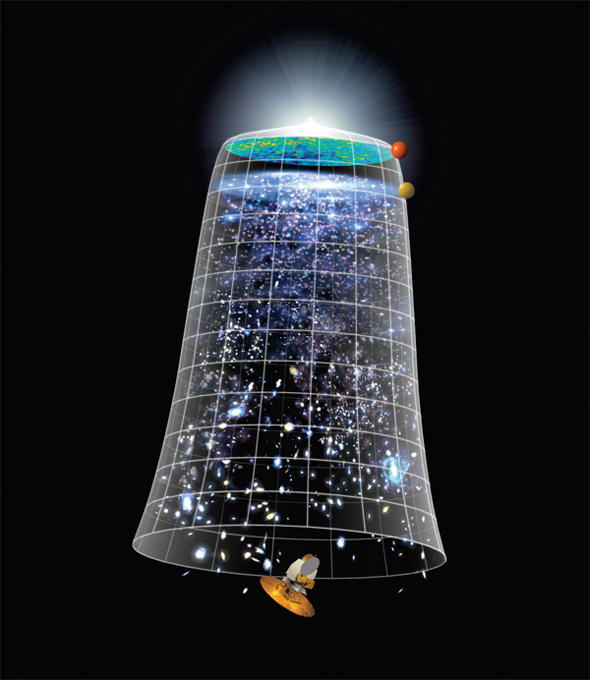
Artist representation of the Big Bang (topmost point). Time proceeds down the page. The universe undergoes a rapid period of initial expansion (up to the red spherical marker). The first stars appear after about 400 million years (denoted by the yellow sphere).
“Glittering stars in the night sky aside,” writes journalist Peter Tyson, “scientists have long known that there are diamonds in the heavens…. Outer space may also be the birthplace of the mysterious black diamonds known as carbonados.”
Various theories continue to be debated with respect to the formation of carbonado diamonds, such as meteorite impacts that can cause extreme pressures needed to trigger the creation of the diamonds in a process known as shock metamorphism. In 2006, researchers Stephen Haggerty, Jozsef Garai, and colleagues reported on studies of carbonado porosity, the presence of various minerals and elements in carbonados, the melt-like surface patina, and other factors that suggested to them that these diamonds formed in carbon-rich exploding stars called supernovae. These stars may produce a high-temperature environment that is analogous to the environments used in chemical vapor deposition methods for producing synthetic diamonds in the laboratory.
The black diamonds are about 2.6 to 3.8 billion years old and may have originally crashed down from space in the form of a large asteroid at a time when South America and Africa were joined. Today, many of these diamonds are found in the Central African Republic and Brazil.
Carbonados are as hard as traditional diamonds, but they are opaque, porous, and made of numerous diamond crystals that are stuck together. Carbonados are sometimes used for cutting other diamonds. Brazilians first discovered the rare black diamonds around 1840 and named them carbonados for their carbonized or burned appearance. In the 1860s, carbonados became useful for tipping drills used to penetrate rocks. The largest carbonado ever found has a mass corresponding to about one and a half pounds (3,167 carats, or 60 carats more massive than the largest clear diamond).
Other forms of naturally occurring (non-carbonado) “black diamonds” include more traditional-looking diamonds that have a smoky, dark coloration resulting from mineral inclusions such as iron oxides or sulfide compounds that cloud the stone. The gorgeous Spirit of de Grisogono at 0.137 pound (312.24 carats) is the world’s largest cut black diamond of this variety.
SEE ALSO Stellar Nucleosynthesis (1946).

According to one theory, exploding stars called supernovae produced the high-temperature environment and carbon required for carbonado formation. Shown here is the Crab Nebula, a remnant of a star’s supernova explosion.
Francis Perrin (1901–1992)
“Creating a nuclear reaction is not simple,” write technologists at the U.S. Department of Energy. “In power plants, it involves splitting uranium atoms, and that process releases energy as heat and neutrons that go on to cause other atoms to split. This splitting process is called nuclear fission. In a power plant, sustaining the process of splitting atoms requires the involvement of many scientists and technicians.”
In fact, it was not until the late 1930s that physicists Enrico Fermi and Leó Szilárd fully appreciated that uranium would be the element capable of sustaining a chain reaction. Szilárd and Fermi conducted experiments at Columbia University and discovered significant Neutron (subatomic particle) production with uranium, proving that the chain reaction was possible and enabling nuclear weapons. Szilárd wrote on the night of the discovery, “there was very little doubt in my mind that the world was headed for grief.”
Because of the complexity of the process, the world was stunned in 1972 when French physicist Francis Perrin discovered that nature had created the world’s first nuclear reactor two billion years before humankind, beneath Oklo in Gabon, Africa. This natural reactor formed when a uranium-rich mineral deposit came in contact with groundwater, which slowed the neutrons ejected from the uranium so that they could interact with and split other atoms. Heat was produced, turning the water to steam, thus temporarily slowing the chain reaction. The environment cooled, water returned, and the process repeated.
Scientists estimate that this prehistoric reactor ran for hundreds of thousands of years, producing the various isotopes (atomic variants) expected from such reactions that scientists detected at Oklo. The nuclear reactions in the uranium in underground veins consumed about five tons of radioactive uranium-235. Aside from the Oklo reactors, no other natural nuclear reactors have been identified. Roger Zelazny creatively speculates in his novel Bridges of Ashes that an alien race created the Gabon mine in order to cause mutations that eventually led to the human race.
SEE ALSO Radioactivity (1896), Neutron (1932), Energy from the Nucleus (1942), Little Boy Atomic Bomb (1945).

Nature created the world’s first nuclear reactor in Africa. Billions of years later, Leó Szilárd and Enrico Fermi held U.S. Patent 2,708,656 on the nuclear reactor. Tank 355 is filled with water to act as a shield for radiation.
At various locations around the world, ancient cultures discovered the physics of killing through the use of an ingenious device called the atlatl. The tool resembles a wooden rod or board with a cup or spur at one end, and it makes use of leverage and other simple physical principles to enable users to hurl a large arrow at a target with a tremendous range (over 328 feet [100 meters]) and speeds exceeding 92 miles per hour (150 kilometers/hour). In some sense, the atlatl functions as an extra arm segment.
A 27,000-year-old atlatl made of reindeer antler was discovered in France. Native Americans used the device 12,000 years ago. Australian Aborigines called the device a woomera. East Africans and Native Alaskans also used atlatl-like devices. The Mayans and Aztecs (who actually called it an atlatl) were fans of the instruments, and the Aztecs surprised the Spanish conquistadors by using atlatls to completely pierce plate armor. Prehistoric hunters could use the atlatl for killing animals as large as the mammoth.
Today, the World Atlatl Association supports both national and international competitions that attract engineers, hunters, and anyone interested in understanding the secrets of prehistoric technology.
One version of the atlatl resembles a two-foot long stick, although it underwent technological evolution over thousands of years. A dart (four to six feet long, or about 1.5 meters) fits into a spur at the back of the atlatl and is initially positioned parallel to the board. The atlatl user launches the dart with a sweeping arm and wrist motion, similar to a tennis serve.
As the atlatl evolved, users discovered that flexible atlatl boards could effectively store and release energy (like a diver on a diving board), and small stone weights were added to the device. The purpose of these weights has been debated through the years. Many feel that the weights add stability and distance to the throw by adjusting the timing and flexibility. It’s also possible that the weights reduce the sound so that the launch is less obvious.
SEE ALSO Crossbow (341 B.C.), Trebuchet (1200), Hypersonic Whipcracking (1927).

Figure from the Fejérváry-Mayer Aztec Codex of central Mexico, depicting a god holding three arrows and an atlatl. This codex dates to a time prior to Hernán Cortés’ destruction of the Aztec capital Tenochtitlan in 1521.
I recall a silly song from childhood by the English singer Charlie Drake (1925–2006), about a sad Australian Aborigine who laments that “My boomerang won’t come back.” In practice, this may have been no problem, because the boomerangs used for hunting kangaroos or in war were heavy curved throwing sticks meant to break the bones of the quarry and not to return. A hunting boomerang, dated to around 20,000 B.C., has been found in a cave in Poland.
Today, when most of us think of boomerangs, we think of boomerangs shaped like the letter V. These shapes probably evolved from the non-returning boomerangs, perhaps when hunters noticed that particular branch shapes were more stable in flight or exhibited interesting flight patterns. The return boomerang is actually used for hunting to scare game birds into flight, though we don’t know when such boomerangs were first invented. Each wing of this kind of boomerang is shaped like an airfoil, similar to the shape of an airplane wing, which is rounded on one side and flatter on the other. Air travels faster over one side of the wing than the other, which assists in providing lift. Unlike an airplane wing, the boomerang has “leading edges” on opposite sides of the V, given that the boomerang spins as it flies. This means that the airfoils face in different directions for the lead wing and the trailing wing.
The boomerang is initially thrown at a slightly off-vertical direction with the open part of the V facing forward. As the boomerang spins in the direction of the throw, the top wing of the boomerang advances faster than the bottom—which also contributes to the lift. Gyroscopic precession, which is a change in the orientation of the rotation axis of a rotating body, allows the boomerang to return to the thrower when thrown correctly. The combination of these factors creates the complex, circular flight path of the boomerang.
SEE ALSO Crossbow (341 B.C.), Trebuchet (1200), Gyroscope (1852).

Boomerangs have been used as weapons and for sport. Their shapes vary and depend on their geographic origins and function.
“Hide not your talents. They for use were made. What’s a sundial in the shade?”
—Ben Franklin
For centuries, people have wondered about the nature of time. Much of ancient Greek philosophy was concerned with understanding the concept of eternity, and the subject of time is central to all the world’s religions and cultures. Angelus Silesius, a seventeenth-century mystic poet, actually suggested that the flow of time could be suspended by mental powers: “Time is of your own making; its clock ticks in your head. The moment you stop thought, time too stops dead.”
One of the oldest of time-keeping devices is the sundial. Perhaps ancient humans noticed that the shadows they cast were long in the early morning, grew progressively shorter, and then grew longer again as the evening approached. The earliest known sundial dates to about 3300 B.C. and is found engraved in a stone in the Knowth Great Mound in Ireland.
A primitive sundial can be made from a vertical stick in the ground. In the northern hemisphere, the shadow rotates around the stick in a clockwise direction, and the shadow’s position can be used to mark the passage of time. The accuracy of such a crude instrument is improved if the stick is slanted so that it points to the Celestial North Pole, or roughly toward the position of the Pole Star. With this modification, the pointer’s shadow will not change with the seasons. One common form of sundial has a horizontal dial, sometimes used as an ornament in a garden. Because the shadow does not rotate uniformly around the face of this sundial, the marks for each hour are not spaced equally. Sundials may not be accurate for various reasons, including the variable speed of the Earth orbiting the Sun, the use of daylight savings time, and the fact that clock times today are generally kept uniform within time zones. Before the days of wristwatches, people sometimes carried a folding sundial in their pockets, attached to a small magnetic compass to estimate true north.
SEE ALSO Antikythera Mechanism (125 B.C.), Hourglass (1338), Anniversary Clock (1841), Time Travel (1949), Atomic Clocks (1955).
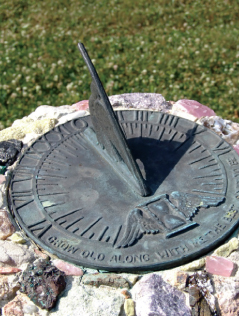
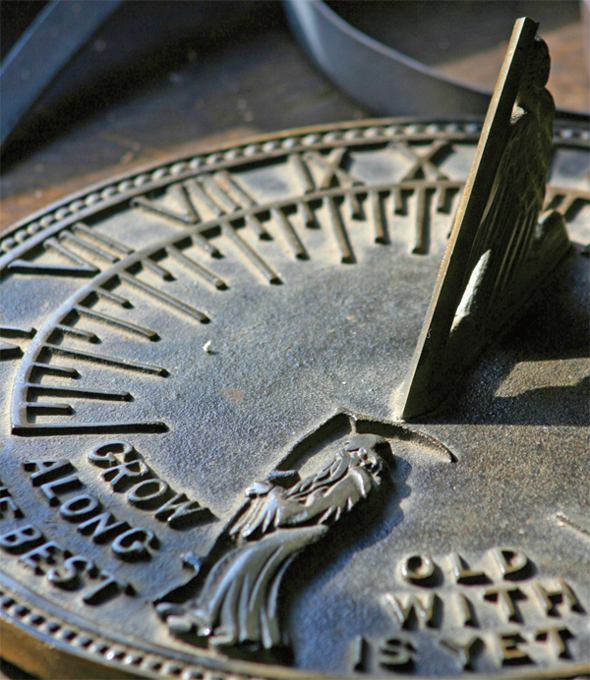
People have always wondered about the nature of time. One of the most ancient of timekeeping devices is the sundial.
Trusses are structures usually composed of several triangular units that are made from straight pieces of metal or wood connected by joints, or nodes. If all members of the truss lie in a plane, the truss is called a planar truss. For centuries, truss structures allowed builders to construct sturdy structures in an economical way, in terms of cost and use of materials. The rigid framework of a truss allowed it to span great distances.
The triangular shape is particularly useful because the triangle is the only shape that cannot experience a change in shape without a change in the length of a side. This means that a triangular frame of strong beams fastened at static joints cannot be deformed. (For example, a square could, in principle, assume the shape of a rhombus, if the joints accidentally slid.) Another advantage of the truss is that its stability can often be predicted by assuming that the beams are stressed primarily in terms of tension and compression and that these forces act at the nodes. If a force tends to elongate a beam, it is a tensile force. If the force tends to shorten the beam, it is a compressive force. Since the nodes of a truss are static, the sum of all forces at each node equals zero.
Wooden trusses were used in ancient lake dwellings during the Early Bronze Age, circa 2500 B.C. Romans used wooden trusses for bridge constructions. In the 1800s, trusses were extensively used in covered bridges in the United States, and numerous patents were filed for various truss configurations. The first iron-truss bridge in the United States was the Frankfort Bridge on the Erie Canal, built in 1840, and the first steel-truss bridge spanned the Missouri River in 1879. After the Civil War, metal-truss railroad bridges were popular, as they offered greater stability than suspension bridges when subject to the moving load of heavy trains.
SEE ALSO Arch (1850 B.C.), I-Beams (1844), Tensegrity (1948), Leaning Tower of Lire (1955).

For centuries, triangular truss structures allowed builders to construct sturdy, cost-effective structures.
In architecture, an arch is a curved structure that spans a space while supporting weight. The arch has also become a metaphor for extreme durability created by the interaction of simple parts. The Roman philosopher Seneca wrote, “Human society is like an arch, kept from falling by the mutual pressure of its parts.” According to an ancient Hindu proverb, “An arch never sleeps.”
The oldest existing arched city gate is the Ashkelon gate in Israel, built c. 1850 B.C. of mud-brick with some calcareous limestone. Mesopotamian brick arches are even older, but the arch gained particular prominence in ancient Rome, where it was applied to a wide range of structures.
In buildings, the arch allows the heavy load from above to be channeled into horizontal and vertical forces on supporting columns. The construction of arches usually relies upon wedge-shaped blocks, called voussoirs, that precisely fit together. The surfaces of neighboring blocks conduct loads in a mostly uniform manner. The central voussoir, at the top of the arch, is called the keystone. To build an arch, a supporting wooden framework is often used until the keystone is finally inserted, locking the arch in place. Once inserted, the arch becomes self-supporting. One advantage of the arch over earlier kinds of supporting structures is its creation from easily transported voussoirs and its spanning of large openings. Another advantage is that gravitational forces are distributed throughout the arch and converted to forces that are roughly perpendicular to voussoirs’ bottom faces. However, this means that the base of the arch is subject to some lateral forces, which must be counterbalanced by materials (e.g. a brick wall) located at the bottom sides of the arch. Much of the force of the arch is converted to compressional forces on the voussoirs—forces that stones, concrete, and other materials can easily withstand. Romans mostly constructed semicircular arches, although other shapes are possible. In Roman aqueducts, the lateral forces of neighboring arches served to counteract each other.
SEE ALSO Truss (2500 B.C.), I-Beams (1844), Tensegrity (1948), Leaning Tower of Lire (1955).

The arch allows the heavy load from above to be channeled into horizontal and vertical forces. Arches usually rely upon wedge-shaped blocks, called voussoirs, that fit closely together as in these ancient Turkish arches.
Michael D. Coe (b. 1929), John B. Carlson (b. 1945)
For many centuries, navigators have used compasses with magnetized pointers for determining the Earth’s magnetic north pole. The Olmec compass in Mesomerica may represent the earliest known compass. The Olmecs were an ancient pre-Columbian civilization situated in south-central Mexico from around 1400 B.C. to 400 B.C. and famous for the colossal artwork in the form of heads carved from volcanic rock.
American astronomer John B. Carlson used Radiocarbon Dating methods of the relevant layers of an excavation to determine that a flattened, polished, oblong piece of hematite (iron oxide) had its origin about 1400–1000 B.C. Carlson has speculated that the Olmecs used such objects as direction indicators for astrology and geomancy, and for orienting burial sites. The Olmec compass is part of a polished lodestone (magnetized piece of the mineral) bar with a groove at one end that was possibly used for sighting. Note that the ancient Chinese invented the compass some time before the second century, and the compass was used for navigation by the eleventh century.
Carlson writes in “Lodestone Compass: Chinese or Olmec Primacy?”
Considering the unique morphology (purposefully shaped polished bar with a groove) and composition (magnetic mineral with magnetic moment vector in the floating plane) of M-160, and acknowledging that the Olmec were a sophisticated people who possessed advanced knowledge and skill in working iron ore minerals, I would suggest for consideration that the Early Formative artifact M-160 was probably manufactured and used as what I have called a zeroth-order compass, if not a first-order compass. Whether such a pointer would have been used to point to something astronomical (zeroth-order compass) or to geomagnetic north-south (first-order compass) is entirely open to speculation.
In the late 1960s, Yale University archeologist Michael Coe found the Olmec bar at San Lorenzo in the Mexican state of Veracruz, and it was tested by Carlson in 1973. Carlson floated it on mercury or on water with a cork mat.
SEE ALSO De Magnete (1600), Ampère’s Law of Electromagnetism (1825), Galvanometer (1882), Radiocarbon Dating (1949).
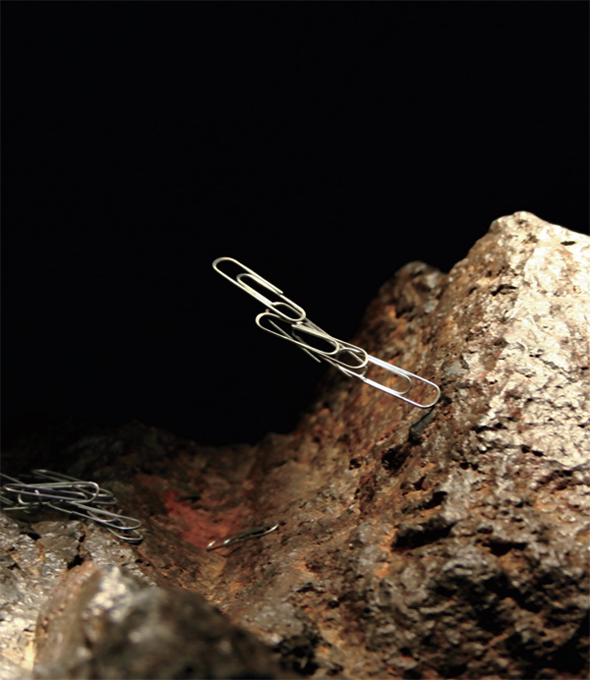
In the most general definition, a lodestone refers to a naturally magnetized mineral, such as those used in fragments that ancient people used to create magnetic compasses. Shown here is a lodestone in the Hall of Gems at the National Museum of Natural History, administered by The Smithsonian Institution.
Through the centuries, the crossbow was a weapon that employed the laws of physics to wreak military havoc and pierce armor. The crossbow changed the odds of victory in war during the Middle Ages. One of the first reliable records of crossbow use in war dates to the battle of Ma-Ling (341 B.C.) in China, but even older crossbows have been found in Chinese tombs.
Early crossbows generally were bows mounted to wooden tillers, or stocks. The short, heavy, arrow-like projectile called a bolt traveled along a groove through the tiller. As the crossbow evolved, various mechanisms were used to pull back the string and then hold the string in place until it was ready to be fired. Early crossbows had stirrups for holding an archer’s foot as he pulled back the string with both hands or with a hook.
Physics improved these killing machines in several ways. A traditional bow and arrow required that the archer be very strong to draw the bow and hold it while aiming. However, with a crossbow, a weaker person could use his leg muscles to assist drawing the string. Later, various levers, gears, pulleys, and cranks were used to amplify the user’s strength when pulling back the string. In the fourteenth century, European crossbows were made of steel and employed crannequins—a toothed wheel attached to a crank. An archer would turn the crank to pull the bowstring.
The penetrating power of a crossbow and ordinary bow comes from energy stored when bending the bow. Like a spring that is pulled and held, energy is stored in the elastic potential energy of the bow. When released, the potential energy is converted to the kinetic energy of movement. The amount of firing power the bow delivers depends on the bow’s draw weight (amount of force needed to draw the bow) and draw length (the distance between the bowstring’s resting position and its drawn position).
SEE ALSO Atlatl (30,000 B.C.), Boomerang (20,000 B.C.), Trebuchet (1200), Conservation of Energy (1843).

Around 1486, Leonardo da Vinci drew several designs for a colossal crossbow. This weapon was cranked using gears. One of its firing mechanisms employed a holding pin that was released by striking it with a mallet.
Alessandro Giuseppe Antonio Anastasio Volta (1745–1827)
In 1800, Italian physicist Alessandro Volta invented what has been traditionally considered to be the first electric battery when he stacked several pairs of alternating copper and zinc discs separated by cloth soaked in salt water. When the top and bottom of the pile were connected by a wire, an electric current began to flow. However, the discovery of certain archeological artifacts may suggest batteries predate this discovery by more than a millennium.
“Iraq has a rich national heritage,” writes the BBC News. “The Garden of Eden and the Tower of Babel are said to have been sited in this ancient land.” In 1938, while in Baghdad, German archeologist Wilhelm König discovered a five-inch-long (13 cm) clay jar containing a copper cylinder that surrounded an iron rod. The jar showed signs of corrosion and seemed to have once contained a mild acid, such as vinegar or wine. König believed these vessels to be galvanic cells, or parts of batteries, possibly used for electroplating gold onto silver objects. The acidic solution would serve as an electrolyte, or conducting medium. The dates of the artifacts are obscure. König dated them to around 250 B.C. to A.D. 224, while others have suggested a range of A.D. 225–640. Subsequent researchers have demonstrated that replicas of the Baghdad Battery do indeed produce electrical current when filled with grape juice or vinegar.
Referring to the batteries in 2003, metallurgist Dr. Paul Craddock notes, “They are a one-off. As far as we know, nobody else has found anything like these. They are odd things; they are one of life’s enigmas.” Various other uses for the Baghdad batteries have been suggested, ranging from their use to produce electrical currents for the purpose of acupuncture or to impress worshipers of idols. If wires or conductors are ever discovered along with other ancient batteries, this would support the idea that these objects functioned as batteries. Of course, even if the vessels did produce electric currents, this does not imply that the ancient people understood how the objects actually worked.
SEE ALSO Von Guericke’s Electrostatic Generator (1660), Battery (1800), Fuel Cell (1839), Leyden Jar (1744), Solar Cells (1954).

The ancient Baghdad battery is composed of a clay jar with a stopper made of asphalt. Protruding through the asphalt is an iron rod surrounded by a copper cylinder. When filled with vinegar, the jar produces about 1.1 volts. (Photo courtesy of Stan Sherer.)
Ctesibius (285-222 B.C.)
A siphon is a tube that allows liquid to drain from a reservoir to another location. An intermediate location in the tube may actually be higher than the reservoir, yet the siphon still operates. No pump is required to maintain the flow of liquid since the flow is driven by differential hydrostatic pressures. The discovery of the siphon principle is often attributed to the Greek inventor and mathematician Ctesibius.
The liquid in a siphon can rise in the tube before flowing downward, partly because the weight of the liquid in the longer “outlet” tube is pulled downward by gravity. In fascinating laboratory experiments, some siphons have been demonstrated to work in a vacuum. The maximum height of the top “crest” of a traditional siphon is limited by atmospheric pressure because if the crest is too high, the pressure in the liquid may drop below the vapor pressure of a liquid, causing bubbles to form in the crest of the tube.
Interestingly, the end of the siphon does not need to be below the mouth of the tube, but it does need to be below the surface of the water in the reservoir. Although siphons are used in countless practical applications for draining liquids, my favorite application is the fanciful Tantalus Cup. In one form, the statue of a little man sits in the cup. A siphon is hidden in the statue with the crest near the level of the man’s chin. As liquid is poured into the cup, it rises to the chin, and then the cup promptly continues to drain most of the cup’s contents through the siphon’s end that is hidden at the bottom! Tantalus is, therefore, thirsty forever….

A Tantalus Cup, with hidden siphon depicted in blue.
SEE ALSO Archimedean Screw (250 B.C.), Barometer (1643), Bernoulli’s Law of Fluid Dynamics (1738), Drinking Bird (1945).

A simple siphon with liquid flowing between containers.
Archimedes’ Principle of Buoyancy
Archimedes (c. 287 B.C.–c. 212 B.C.)
Imagine that you are weighing an object—like a fresh, uncooked egg—that is submerged in a kitchen sink. If you weigh the egg by hanging it from a scale, the egg would weigh less while in the water, according to the scale, than when the egg is lifted out of the sink and weighed. The water exerts an upward force that partially supports the weight of the egg. This force is more obvious if we perform the same experiment with an object of lower density, such as a cube made out of cork, which floats while being partially submerged in the water.

An egg in water experiences an upward force equal to the weight of water it displaces.
The force exerted by the water on the cork is called a buoyant force, and for a cork held under water, the upward force is greater than its weight. This buoyant force depends on the density of the liquid and the volume of the object, but not on the shape of the object or the material of which the object is composed. Thus, in our experiment, it doesn’t matter if the egg is shaped like a sphere or a cube. An equal volume of egg or wood would experience the same buoyant force in water.
According to Archimedes’ Principle of Buoyancy, named after the Greek mathematician and inventor famous for his geometric and hydrostatic studies, a body wholly or partially submerged in liquid is buoyed up by a force equal to the weight of displaced liquid.
As another example, consider a small pellet of lead placed in a bathtub. The pellet weighs more than the tiny weight of water it displaces, so the pellet sinks. A wooden rowboat is buoyed up by the large weight of water that it displaces, and hence the rowboat floats. A submarine floating underwater displaces a volume of water that has a weight that is precisely equal to the submarine’s weight. In other words, the total weight of the submarine—which includes the people, the metal hull, and the enclosed air-equals the weight of displaced seawater.
SEE ALSO Archimedean Screw (250 B.C.), Stokes’ Law of Viscosity (1851), Lava Lamp (1963).

When plesiosaurs (extinct reptiles) floated within the sea, their total weights equaled the weights of the water they displaced. Gastrolith stones discovered in the stomach region of plesiosaur skeletons may have helped in controlling buoyancy and flotation.
Archimedes (c. 287 B.C.–c. 212 B.C.), Marcus Vitruvius Pollio (c. 87 B.C.–c. 15 B.C.)
Archimedes, the ancient Greek geometer, is often regarded as the greatest mathematician and scientist of antiquity and one of the four greatest mathematicians to have walked the earth—together with Isaac Newton, Leonhard Euler, and Carl Friedrich Gauss.
The invention of the water snail, or Archimedean screw, to raise water and help irrigate crops was attributed to Archimedes by the Greek historian Diodorus Siculus in the first century B.C. The Roman engineer Vitruvius gives a detailed description of its operation for lifting water, which required intertwined helical blades. In order to lift water, the bottom end of the screw is immersed in a pond, after which the act of rotating the screw raises water from the pond to a higher elevation. Archimedes may also have designed a related helical pump, a corkscrew-like device used to remove water from the bottom of a large ship. The Archimedean screw is still used today in societies without access to advanced technology and works well even if the water is filled with debris. It also tends to minimize damage to aquatic life. Modern Archimedean screw-like devices are used to pump sewage in water-treatment plants.
Author Heather Hassan writes, “Some Egyptian farmers are still using the Archimedean screw to irrigate their fields. It ranges in size from a quarter of an inch to 12 feet (0.6 centimeters to 3.7 meters) in diameter. The screw is also used in the Netherlands, as well as in other countries, where unwanted water needs to be drained from the surface of the land.”
Additional intriguing modern examples exist. Seven Archimedes screws are used to pump wastewater in a treatment plant in Memphis, Tennessee. Each of these screws is 96 inches (2.44 meters) in diameter and can lift 19,900 gallons (about 75,000 liters) per minute. According to mathematician Chris Rorres, an Archimedean screw the diameter of a pencil eraser is used in a Hemopump cardiac assist system that maintains blood circulation during heart failure, coronary bypass surgery, and other surgical procedures.
SEE ALSO Siphon (250 B.C.), Archimedes’ Principle of Buoyancy (250 B.C.).
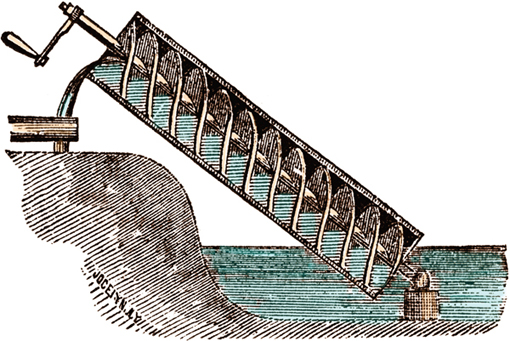
Archimedean screw, from Chambers’s Encyclopedia, 1875.
Eratosthenes Measures the Earth
Eratosthenes of Cyrene (c. 276 B.C.–c. 194 B.C.)
According to author Douglas Hubbard, “Our first mentor of measurement did something that was probably thought by many in his day to be impossible. An ancient Greek named Eratosthenes made the first recorded measurement of the circumference of Earth…. [He] didn’t use accurate survey equipment, and he certainly didn’t have lasers and satellites….” However, Eratosthenes knew of a particular deep well in Syene, a city in southern Egypt. The bottom of this well was entirely lit by the noon Sun one day out of the year, and thus the sun was directly overhead. He also was aware that, at the same time in the city of Alexandria, objects cast a shadow, which suggested to Eratosthenes that the Earth was spherical, not flat. He assumed that the Sun’s rays were essentially parallel, and he knew that the shadow made an angle that was 1/50th of a circle. Thus, he determined that the circumference of the Earth must be approximately 50 times the known distance between Alexandria and Syene. Assessments of Eratosthenes’ accuracy vary, due to the conversion of his ancient units of measure to modern units, along with other factors, but his measurements are usually deemed to be within a few percent of the actual circumference. Certainly, his estimation was more accurate than other estimates of his day. Today, we know that the circumference of the Earth at the equator is about 24,900 miles (40,075 kilometers). Curiously, if Columbus had not ignored the results of Eratosthenes, thereby underestimating the circumference of the Earth, the goal of reaching Asia by sailing west might have been considered to be an impossible task.
Eratosthenes was born in Cyrene (now in Libya) and later was a director of the great Library of Alexandria. He is also famous for founding scientific chronology (a system that endeavors to fix dates of events at correctly proportioned intervals), along with developing a simple algorithm for identifying prime numbers (numbers such as 13, divisible only by themselves and 1). In old age, Eratosthenes became blind and starved himself to death.
SEE ALSO Pulley (230 B.C.), Measuring the Solar System (1672), Black Drop Effect (1761), Stellar Parallax (1838), Birth of the Meter (1889).
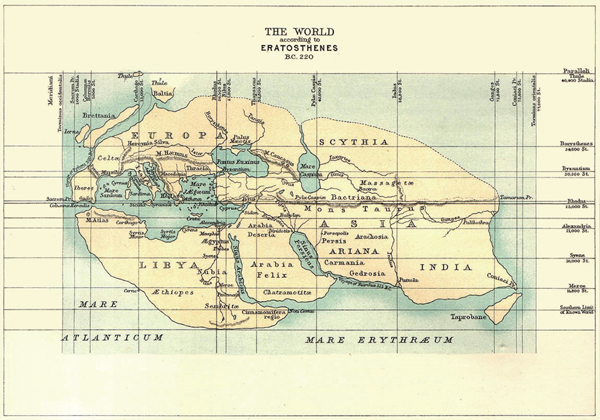
Eratosthenes’ map of the world (1895 reconstruction). Eratosthenes measured the circumference of the Earth without leaving Egypt. Ancient and medieval European scholars often believed that the world was spherical, although they were not aware of the Americas.
Archimedes (c. 287 B.C.–c. 212 B.C.)
A pulley is a mechanism that usually consists of a wheel on an axle. A rope runs over the wheel so that the pulley can change the direction of an applied force, for example, when helping a human or a machine lift or pull heavy loads. The pulley also makes it easier to move a load because it decreases the applied force needed.
The pulley probably had its birth in prehistoric times when someone tossed a rope over a horizontal tree branch and used it to lift a heavy object. Author Kendall Haven writes, “By 3000 B.C., such pulleys with grooved wheels (so that the rope wouldn’t slip off) existed in Egypt and Syria. The Greek mathematician and inventor Archimedes gets credit for inventing the compound pulley in about 230 B.C…. in which a number of wheels and ropes combine to lift a single object … to multiply the lifting power of a person. Modern block and tackle systems are examples of compound pulleys.”
Pulleys almost seem magical in the way they can decrease the width and strength of the rope required, and of the force needed, to lift heavy objects. In fact, according to legends and the writings of the Greek historian Plutarch, Archimedes may have used a compound pulley to help move heavy ships with minimal effort. Of course, no laws of nature are violated. Work, which is defined as force times the distance moved, remains the same—pulleys allow one to pull with less force but over a longer distance. In practice, more pulleys increase the sliding friction, and, thus, a system of pulleys may become decreasingly efficient after a certain number are employed. When performing computations to estimate the effort needed to use a pulley system, engineers often assume that the pulley and rope weigh very little compared to the weight that is being moved. Through history, block-and-tackle systems were particularly common on sailing ships, where motorized aids were not always available.
SEE ALSO Atlatl (30,000 B.C.), Crossbow (341 B.C.), Foucault’s Pendulum (1851).

Close-up of a pulley system on a vintage yacht. Ropes in pulleys travel over wheels so that the pulley can change the direction of applied forces and make it easier to move a load.
Archimedes (c. 287 B.C.–c. 212 B.C.)
The tale of Archimedes’ burning mirrors has fascinated historians through the centuries. In 212 B.C., Archimedes is said to have made a “death ray” consisting of a set of mirrors that focused sunlight on Roman ships, setting them afire. Various individuals have tried to test the practical use of such mirrors and declared their use to have been unlikely. However, mechanical engineer David Wallace of MIT encouraged his students in 2005 to build an oak replica of a Roman warship and focus sunlight on it, using 127 flat mirrors, each with an edge one foot (0.3 meter) in length. The ship was about 100 feet (30 meters) away. After ten minutes of exposure to the focused light, the warship burst into flames!
In 1973, a Greek engineer employed 70 flat mirrors (each about five feet by three feet in length, or 1.5 × 0.9 meter) in order to focus sunlight onto a rowboat. In this experiment, the rowboat also quickly burst into flames. However, while it is possible to set a ship afire with mirrors, this task would have probably been very difficult for Archimedes if ships were moving.
As an interesting aside, Arthur C. Clarke’s short story, “A Slight Case of Sunstroke” describes the fate of a disliked soccer referee. When the referee makes an unpopular decision, the spectators focus sunlight onto the referee using their shiny souvenir programs that they hold in their hands. The shiny surfaces act like Archimedes’ mirror, and the poor man is burned to ashes.
Archimedes developed other weapons. According to Greek historian Plutarch, Archimedes’ ballistic weaponry was used effectively against the Romans in the siege of 212 B.C. For example, Plutarch wrote, “When Archimedes began to ply his engines, he at once shot all sorts of missile weapons against the land forces, and immense masses of stone that came down with incredible noise and violence, against which no man could stand; for they knocked down those upon whom they fell in heaps….”

Wood engraving of a burning mirror from F. Marion’s The Wonders of Optics (1870).
SEE ALSO Fiber Optics (1841), Solar Cells (1954), Laser (1960), Unilluminable Rooms (1969).

The largest solar furnace in the world is in Odeillo, France. An array of plane mirrors (not shown) reflects sunlight onto the large curved mirror, which focuses light onto a small area that reaches temperatures of 5,430 °F (3,000 °C).
Valerios Stais (1857–1923)
The Antikythera mechanism is an ancient geared computing device that was used to calculate astronomical positions and that mystified scientists for over a century. Discovered around 1902 by archaeologist Valerios Stais in a shipwreck off the coast of the Greek island Antikythera, the device is thought to have been built about 150–100 B.C. Journalist Jo Marchant writes, “Among the salvaged hoard subsequently shipped to Athens was a piece of formless rock that no one noticed at first, until it cracked open, revealing bronze gearwheels, pointers, and tiny Greek inscriptions…. A sophisticated piece of machinery consisting of precisely cut dials, pointers and at least thirty interlocking gear wheels, nothing close to its complexity appears again in the historical record for more than a thousand years, until the development of astronomical clocks in medieval Europe.”
A dial on the front of the device probably carried at least three hands, one indicating the date and the other two indicating the positions of the Sun and the Moon. The device was also probably used to track dates of ancient Olympic games, predict solar eclipses, and indicate other planetary motions.
Of special delight to physicists, the Moon mechanism uses a special train of bronze gears, two of them linked with a slightly offset axis, to indicate the position and phase of the moon. As is known today from Kepler’s Laws of Planetary Motion, the moon travels at different speeds as it orbits the Earth (e.g. faster when it is closer to the Earth), and this speed differential is modeled by the Antikythera mechanism, even though the ancient Greeks were not aware of the actual elliptical shape of the orbit. Additionally, the Earth travels faster when it is closer to the Sun than when it is far away.
Marchant writes, “By turning the handle on the box you could make time pass forwards or backwards, to see the state of the cosmos today, tomorrow, last Tuesday or a hundred years in the future. Whoever owned this device must have felt like master of the heavens.”
SEE ALSO Sundial (3000 B.C.), Gears (50), Kepler’s Laws of Planetary Motion (1609).

The Antikythera mechanism is an ancient geared computing device that was used to calculate astronomical positions. X-ray radiographs of the mechanism have revealed information about the device’s internal configuration. (Photo courtesy of Rien van de Weijgaert.)
Hero (or Heron) of Alexandria (c. 10–c. 70 A.D.), Marcus Vitruvius Pollio (c. 85 B.C.–c. 15 B.C.), Ctesibius (c. 285–c. 222 B.C.)
The history of modern rockets can be traced back through countless experiments to the ancient Greek mathematician and engineer Hero of Alexandria, who invented a rocketlike device called an aeolipile that used steam for propulsion. Hero’s engine consisted of a sphere mounted on top of a kettle of water. A fire below the kettle produced steam that traveled through pipes into the sphere. Steam escaped through two bent tubes on opposite sides of the sphere, providing sufficient thrust so that the sphere would rotate. Because of friction in the bearings, Hero’s engine does not spin increasingly fast but achieves a steady-state speed.
Both Hero and the Roman engineer Vitruvius were fascinated by these kinds of steam-powered devices, as well as the earlier Greek inventor Ctesibius. Historians of science are not certain as to whether Hero’s engine served any practical purpose at the time. According to the 1865 Quarterly Journal of Science, “From the time of Hero we hear nothing more of the application of steam till the beginning of the seventeenth century. In a work published about 1600, Hero’s engine is recommended to be used for turning spits, its great advantages being that the partakers of roasted meat may feel confident ‘that the haunch has not been pawed by the turnspit (in the absence of the housewife’s eye), for the pleasure of licking his unclean fingers’.”
Jet and rocket engines rely on Newton’s Third Law of Motion, which states for every action (force in one direction) there is an equal and opposite reaction (force in the opposite direction). One can see this principle in operation when an inflated, untied balloon is released into the air. The first jet-propelled aircraft was the German Heinkel He 178, which first flew in 1939.
SEE ALSO Newton’s Laws of Motion and Gravitation (1687), Charles’ Gas Law (1787), Tsiolkovsky Rocket Equation (1903).

John R. Bentley created and photographed his replica of Hero’s Engine that spins almost silently at 1,500 rpm with a steam pressure of only 1.8 pounds per square inch, producing surprisingly little visible exhaust.
Hero (or Heron) of Alexandria (c. 10-c. 70 AD.)
Rotating gears, with their intermeshed teeth, have played a crucial role in the history of technology. Not only are gear mechanisms important for increasing the applied twisting force, or torque, but gears are also useful for changing the speed and direction of force. One of the oldest machines is a potter’s wheel, and primitive gears associated with these kinds of wheels probably existed for thousands of years. In the fourth century B.C., Aristotle wrote about wheels using friction between smooth surfaces to convey motions. Built around 125 B.C., the Antikythera Mechanism employed toothed gears for calculating astronomical positions. One of the earliest written references to toothed gears was made by Hero of Alexandria, c. 50 A.D. Through time, gears have played a crucial role in mills, clocks, bicycles, cars, washing machines, and drills. Because they are so useful in amplifying forces, early engineers used them for lifting heavy construction loads. The speed-changing properties of gear assemblies were put to use when ancient textile machines were powered by the movement of horses or water. The rotational speed of these power supplies was often insufficient, so a set of wooden gears was used to increase the speed for textile production.
When two gears are intermeshed, the rotational speed ratio s1/s2 is simply the reciprocal ratio of the number n of teeth on the two gears: s1/s2 = n2/n1. Thus, a small gear turns faster than its larger partner. The torque ratio has an opposite relationship. The larger gear experiences greater torque, and the higher torque implies lower velocity. This is useful, for example, for electric screwdrivers, in which the motor can produce a small amount of torque at high speed, but we wish to have a slow output speed with increased torque.
Among the simplest gears are spur gears, with their straight-cut teeth. Helical gears in which the teeth are set at an angle have the advantage of running more smoothly and quietly and usually being able to handle greater torques.
SEE ALSO Pulley (230 B.C.) Antikythera Mechanism (125 B.C.) Hero’s Jet Engine (50).

Gears have played important roles in history. Gear mechanisms can increase the applied force or torque and are also useful for changing the speed and direction of a force.
Gaius Plinius Secundus (Pliny the Elder) (23–79)
“Everything is in flames,” exclaimed Charles Darwin aboard his sailing ship, “the sky with lighting—the water with luminous particles, and even the masts are pointed with an blue flame.” What Darwin was experiencing was St. Elmo’s fire, a natural phenomenon that has ignited superstitions for millennia. The Roman philosopher Pliny the Elder makes reference to the “fire” in his Naturalis Historia around 78 A.D.
Often described as a ghostly blue-white dancing flame, this is actually an electrical weather phenomenon in which a glowing Plasma, or ionized gas, emits light. The plasma is created by atmospheric electricity, and the eerie glow often appears at the tips of pointed objects such as church towers or the masts of ships during stormy weather. St. Elmo was the patron saint of Mediterranean sailors, who regarded St. Elmo’s fire as a good omen because the glow was often brightest near the end of a storm. Sharp pointed objects encourage the formation of the “fire” because electric fields are more concentrated in areas of high curvature. Pointed surfaces discharge at a lower voltage level than surfaces without points. The color of the fire arises from the nitrogen and oxygen composition of the air and their associated fluorescence. If the atmosphere were neon, the fire would be orange, just like a Neon Sign.
“On dark stormy nights,” writes scientist Philip Callahan, “St. Elmo’s fire is probably responsible for more ghost stories and tales of apparitions than any other natural phenomenon.” In Moby Dick, Herman Melville describes the fire during a typhoon: “All the yard-arms were tipped with a pallid fire; and touched at each tri-pointed lightning-rod-end with three tapering white flames, each of the three tall masts was silently burning in that sulphurous air, like three gigantic wax tapers before an altar…. ‘The corpusants have mercy on us all!’ … In all my voyagings seldom have I heard a common oath when God’s burning finger has been laid on the ship.”
SEE ALSO Aurora Borealis (1621), Ben Franklin’s Kite (1752), Plasma (1879), Stokes’ Fluorescence (1852), Neon Signs (1923).

“St. Elmo’s Fire on Mast of Ship at Sea” in The Aerial World, by Dr. G. Hartwig, London, 1886.
Niccolò Fontana Tartaglia (1500–1557), Han Shizhong (1089–1151)
The cannon, which generally fires heavy projectiles using gunpowder, focused Europe’s most brilliant minds on questions regarding the forces and laws of motion. “Ultimately it was the effects of gunpowder on science rather than on warfare that were to have the greatest influence in bringing about the Machine Age,” writes historian J. D. Bernal. “Gunpowder and cannon not only blew up the medieval world economically and politically; they were major forces in destroying its system of ideas.” Author Jack Kelley remarks, “Both gunners and natural philosophers wanted to know: What happens to the cannonball after it leaves the barrel of the gun? The search for a definitive answer took four hundred years and required the creation of entirely new fields of science.”
The first documented use of gunpowder artillery in war is the 1132 capturing of a city in Fujian, China, by Chinese general Han Shizhong. During the Middle Ages, cannons became standardized and more effective against soldiers and fortifications. Later, cannons transformed war at sea. In the American Civil War, the howitzer had an effective range of over 1.1 miles (1.8 kilometers), and in World War I, cannons caused the majority of all deaths in action.
In the 1500s, it was realized that gunpowder produced a large volume of hot gas that exerted pressure on the cannon ball. Italian engineer Niccolò Tartaglia assisted gunners in determining that an elevation of 45 degrees gave a cannon the longest shot (which we know today is only an approximation, due to the effects of air resistance). Galileo’s theoretical studies showed that gravity constantly accelerated the fall of a cannonball, producing an idealized trajectory in the shape of a parabolic curve, which every cannonball traces regardless of its mass or initial firing angle. Although air resistance and other factors play a complicating role in cannon firing, the cannon “provided a focus for the scientific investigation of reality,” writes Kelly, “one that overturned long-standing error and laid the foundation for a rational age.”
SEE ALSO Atlatl (30,000 B.C.), Crossbow (341 B.C.), Trebuchet (1200), Tsiolkovsky Rocket Equation (1903), Golf Ball Dimples (1905).

Medieval cannon on the bastions of the Citadel in Gozo, Malta.
Bhaskara II (1114–1185), Richard Phillips Feynman (1918–1988)
Although the construction of apparent perpetual motion machines may seem like an unlikely topic for a book on milestones in physics, important advances in physics often involve ideas at the fringes of physics, especially when scientists work to determine why a device violates the laws of physics.
Perpetual motion machines have been proposed for centuries, such as in 1150 when the Indian mathematician-astronomer Bhaskara II described a wheel with mercury-filled containers that he believed would turn forever as the mercury moved within the containers, keeping the wheel heavier on one side of the axle. More generally, perpetual motion often refers to any device or system that either: 1) forever produces more energy than it consumes (a violation of the law of Conservation of Energy) or 2) spontaneously extracts heat from its surroundings to produce mechanical work (a violation of the Second Law of Thermodynamics).
My favorite perpetual motion machine is Richard Feynman’s Brownian Ratchet, discussed in 1962. Imagine a tiny ratchet attached to a paddlewheel that is submerged in water. Because of the one-way ratchet mechanism, when molecules randomly collide with the paddle wheel, the wheel can turn only in one direction and can presumably be used to perform work, such as lifting a weight. Thus, through using a simple ratchet, which might consist of a pawl that engages sloping teeth of a gear, the paddle spins forever. Amazing!
However, Feynman himself showed that his Brownian Ratchet must have a very tiny pawl to respond to the molecular collisions. If the temperature T of the ratchet and pawl were the same as that of the water, the tiny pawl would intermittently fail, and no net motion would occur. If T was less than the temperature of the water, the paddle wheel might be made to go only in one direction, but in doing so, it would make use of energy from the temperature gradient, which does not violate the Second Law of Thermodynamics.
SEE ALSO Brownian Motion (1827), Conservation of Energy (1843), Second Law of Thermodynamics (1850), Maxwell’s Demon (1867), Superconductivity (1911), Drinking Bird (1945).

Cover of the October, 1920 issue of Popular Science magazine, painted by American illustrator Norman Rockwell (1894–1978), showing an inventor researching a perpetual motion machine.
The dreaded trebuchet employs simple laws of physics to cause mayhem. In the Middle Ages, this catapult-like device was used to smash through walls by hurling projectiles, using the principle of the lever and centrifugal force to hold a sling taut. Sometimes, the bodies of dead soldiers or rotting animals were shot over the walls of castles in order to spread disease.
Traction trebuchets, which required men to pull on a rope trigger, were used in the Greek world and in China in the fourth century B.C. The counterweight trebuchet (which we will simply call trebuchet hereafter) replaced the men with a heavy weight and did not appear in China, with certainty, until about 1268. The trebuchet has one part that resembles a seesaw. A heavy weight is attached to one end. At the other end is a ropelike sling that holds a projectile. As the counterweight descends, the sling swings to a vertical position, at which point a mechanism releases the projectile in the direction of the target. This approach is much more powerful than traditional catapults without the sling, in terms of projectile speed and distance. Some trebuchets placed the counterweight closer to the fulcrum (pivot point) of the swing in order to achieve a mechanical advantage. The force of the counterweight is large, and the load is small—like dropping an elephant on one side and transferring energy rapidly to a brick on the other.
The trebuchet was used by the crusaders and also by Islamic armies at various times in history. In 1421, the future Charles VII of France had his engineers build a trebuchet that could shoot a 1,760-pound (800-kilogram) stone. An average range was around 984 feet (300 meters).
Physicists have studied the mechanics of the trebuchet because although it may seem simple, the system of differential equations that governs its motion is very nonlinear.
SEE ALSO Atlatl (30,000 B.C.), Boomerang (20,000 B.C.), Crossbow (341 B.C.), Cannon (1132).
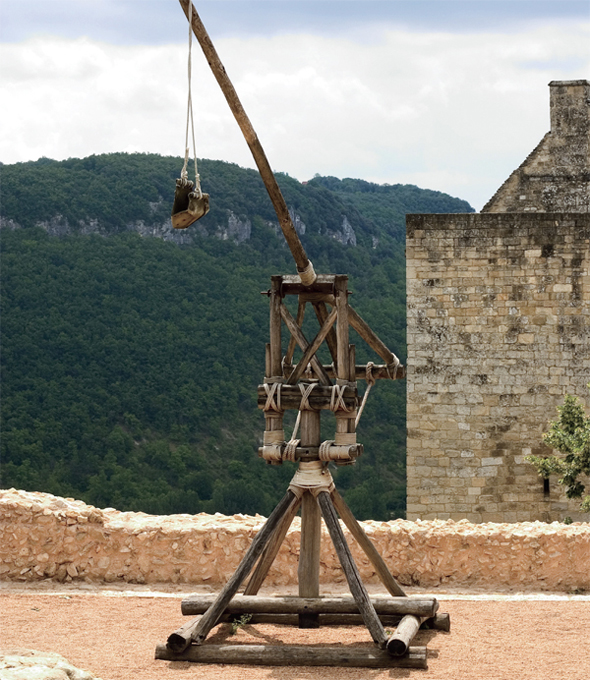
Trebuchet in the Castle of Castelnaud, a medieval fortress in Castelnaud-la-Chapelle, overlooking the Dordogne River in Périgord, southern France.
Abu Ali al-Hasan ibn al-Haytham (965–1039), Kamal al-Din al-Farisi (1267–c. 1320), Theodoric of Freiberg (c. 1250–c. 1310)
“Who among us has not admired the majestic beauty of a rainbow arching silently across a storm’s wake?” write authors Raymond Lee, Jr. and Alistair Fraser. “Vivid and compelling, this image recalls childhood memories, venerable folklore, and perhaps some half-remembered science lessons…. Some societies see the rainbow as an ominous serpent arching across the sky, while others imagine it to be a tangible bridge between the gods and humanity.” The bow spans some modern divides between the arts and sciences.
Today we know that the attractive colors of the rainbow are a result of sunlight that is first refracted (experiences a change in direction) as it enters the surface of the raindrop, and then is reflected off the back of the drop toward the observer, and refracted a second time as it leaves the drop. The separation of white light into various colors occurs because different wavelengths—which correspond to various colors—refract at different angles.
The first correct explanations of rainbows, which involved two refractions and a reflection, were independently provided at about the same time by Kamal al-Din al-Farisi and Theodoric of Freiberg. Al-Farisi was a Persian Muslim scientist born in Iran who conducted experiments using a transparent sphere filled with water. Theodoric of Freiberg, a German theologian and physicist, used a similar experimental setup.
It is fascinating the degree to which simultaneous discoveries appear in great works of science and mathematics. For example, various gas laws, the Möbius strip, calculus, the theory of evolution, and hyperbolic geometry were all developed simultaneously by different individuals. Most likely, such simultaneous discoveries have occurred because the time was “ripe” for such discoveries, given humanity’s accumulated knowledge at the time the discoveries were made. Sometimes, two scientists, working separately, are stimulated by reading the same preliminary research. In the case of the rainbow, both Theodoric and al-Farisi relied on the Book of Optics by the Islamic polymath Ibn al-Haytham (Alhazen).
SEE ALSO Snell’s Law of Refraction (1621), Newton’s Prism (1672), Rayleigh Scattering (1871), Green Flash (1882).

In the Bible, God shows Noah a rainbow as a sign of God’s covenant (painting by Joseph Anton Koch [1768–1839]).

Rainbow colors result from sunlight that is refracted and reflected within water droplets.
Ambrogio Lorenzetti (1290-1348)
The French author Jules Renard (1864-1910) once wrote, “Love is like an hourglass, with the heart filling up as the brain empties.” Hourglasses, also known as sandglasses, measure time using fine sand that flows through a narrow neck from an upper reservoir. The measured length of time depends on many factors, including the volume of sand, the shape of the bulbs, the width of the neck, and the type of sand used. Although hourglasses were probably in use in the third century B.C., the first recorded evidence of hourglasses did not appear until the 1338 fresco Allegory of Good Government by Italian painter Ambrogio Lorenzetti. Interestingly, the sailing ships of Ferdinand Magellan retained 18 hourglasses per ship as he attempted to circumnavigate the globe. One of the largest hourglasses—39 feet (11.9 meters) in height—was built in 2008 in Moscow. Through history, hourglasses were used in factories and to control the duration of sermons in church.
In 1996, British researchers at the University of Leicester determined that the rate of flow depends only on the few centimeters above the neck and not on the bulk of sand above that. They also found that small glass beads known as ballotini gave the most reproducible results. “For a given volume of ballotini,” the researchers write, “the period is controlled by their size, the size of the orifice, and the shape of the reservoir. Provided the aperture is at least 5 times the particle diameter, the period P is given by the expression P = KV(D − d)−2.5, where P is measured in seconds, V denotes the bulk volume of ballotini in ml, d the maximum bead diameter in mm…, and D the diameter of a circular orifice in mm. The constant of proportionality K depends on the shape of the reservoir.” For example, the researchers found different values of K for conical container shapes and hourglass shapes. Any disturbance to the hourglass lengthened the period of time, but changes in temperature produced no observable effect.
SEE ALSO Sundial (3000 B.C.), Anniversary Clock (1841), Time Travel (1949), Atomic Clocks (1955).

Hourglasses were probably in use in the third century. Ferdinand Magellan’s sailing ships had 18 hourglasses per ship when he attempted to circumnavigate the globe.
Nicolaus Copernicus (1473–1543)
“Of all discoveries and opinions,” wrote the German polymath Johann Wolfgang von Goethe in 1808, “none may have exerted a greater effect on the human spirit than the doctrine of Copernicus. The world had scarcely become known as round and complete in itself when it was asked to waive the tremendous privilege of being the center of the universe. Never, perhaps, was a greater demand made on mankind—for by this admission so many things vanished in mist and smoke! What became of our Eden, our world of innocence, piety and poetry; the testimony of the senses; the conviction of a poetic-religious faith?”
Nicolaus Copernicus was the first individual to present a comprehensive heliocentric theory that suggested the Earth was not the center of the universe. His book, De revolutionibus orbium coelestium (On the Revolutions of the Celestial Spheres) was published in 1543, the year he died, and put forward the theory that the Earth revolved around the Sun. Copernicus was a Polish mathematician, physician, and classical scholar—astronomy was something he studied in his spare time—but it was in the field of astronomy that he changed the world. His theory relied on a number of assumptions: that the Earth’s center is not the center of the universe, that the distance from the Earth to the Sun is miniscule when compared with the distance to the stars, that the rotation of the Earth accounts for the apparent daily rotation of the stars, and that the apparent retrograde motion of the planets (in which they appear to briefly stop and reverse directions at certain times when viewed from the Earth) is caused by the motion of the Earth. Although Copernicus’ proposed circular orbits and epicycles of planets were incorrect, his work motivated other astronomers, such as Johannes Kepler, to investigate planetary orbits and later discover their elliptical nature.
Interestingly, it was not until many years later, in 1616, that the Roman Catholic Church proclaimed that Copernicus’ heliocentric theory was false and “altogether opposed to Holy Scripture.”
SEE ALSO Mysterium Cosmographicum (1596), Telescope (1608), Kepler’s Laws of Planetary Motion (1609), Measuring the Solar System (1672), Hubble Telescope (1990).

Orreries are mechanical devices that show positions and motions of the planets and moons in a heliocentric model of the solar system. Shown here is a device constructed in 1766 by instrument-maker Benjamin Martin (1704–1782) and used by astronomer John Winthrop (1714–1779) to teach astronomy at Harvard University. On display at the Putnam Gallery in the Harvard Science Center.
Johannes Kepler (1571–1630)
Throughout his life, German astronomer Johannes Kepler attributed his scientific ideas and motivation to his quest for understanding the mind of God. For example, in his work Mysterium Cosmographicum (The Sacred Mystery of the Cosmos, 1596), he wrote, “I believe that Divine Providence intervened so that by chance I found what I could never obtain by my own efforts. I believe this all the more because I have constantly prayed to God that I might succeed.”
Kepler’s initial vision of the universe rested upon his studies of symmetrical, three-dimensional objects known as Platonic solids. Centuries before Kepler, the Greek mathematician Euclid (325 B.C.–265 B.C.) showed that only five such solids exist with identical faces: the cube, dodecahedron, icosahedron, octahedron, and tetrahedron. Although Kepler’s sixteenth-century theory seems strange to us today, he attempted to show that the distances from the planets to the Sun could be found by studying spheres inside these regular polyhedra, which he drew nested in one another like layers of an onion. For example, the small orbit of Mercury is represented by the innermost sphere in his models. The other planets known at his time were Venus, Earth, Mars, Jupiter, and Saturn.
In particular, an outer sphere surrounds a cube. Inside the cube is a sphere, followed by a tetrahedron, followed by another sphere, followed by a dodecahedron, followed by a sphere, an icosahedron, sphere, and finally a small inner octahedron. A planet may be imagined as being embedded in each sphere that defines an orbit of a planet. With a few subtle compromises, Kepler’s scheme worked fairly well as a rough approximation to what was known about planetary orbits at the time. Owen Gingerich writes, “Although the principal idea of the Mysterium Cosmographicum was erroneous, Kepler established himself as the first… scientist to demand physical explanations for celestial phenomena. Seldom in history has so wrong a book been so seminal in directing the future course of science.”
SEE ALSO Sun-Centered Universe (1543), Kepler’s Laws of Planetary Motion (1609), Measuring the Solar System (1672), Bode’s Law of Planetary Distances (1766).

Kepler’s initial vision of the universe relied on his studies of symmetrical, three-dimensional objects known as Platonic solids. This diagram is from his Mysterium Cosmographicum, published in 1596.
William Gilbert (1544–1603)
William Gilbert’s book De Magnete, published in 1600, is considered to be the first great work on physical science to be produced in England, and much of European science had its roots in Gilbert’s initial theories and fondness for experiments. A personal physician to Queen Elizabeth I, Gilbert is one of the important fathers of the science of electricity and magnetism.
“In the 1500s,” writes author and engineer Joseph F. Keithley, “strong feelings abounded that knowledge was God’s domain, and therefore humans should not pry into it. Experiments were considered to be dangerous to intellectual and moral life…. Gilbert, however, broke with traditional ways of thinking and was impatient” with those who did not use experiments to probe the workings of reality.
In his research in terrestrial magnetism, Gilbert created a spherical lodestone, about a foot (0.3 meter) in diameter, which he called a terrella (little Earth). By moving a small magnetic needle on a pivot around the terrella’s surface, he showed that the terrella had a North and South Pole, and that the needle dipped as it neared a pole, which mimics the dipping of compass needles on the Earth as they approach the poles. He postulated that the Earth was like a giant lodestone. British ships had depended on the magnetic compass, but its working was a mystery. Some had thought that the Pole Star was the actual cause of the magnetic attraction of a compass needle. Others thought there was a magnetic mountain or island at the North Pole, which ships had better avoid because the iron nails of sailing ships would be torn out. Scientists Jacqueline Reynolds and Charles Tanford write, “Gilbert’s demonstration that the Earth and not the heavens held the power went far beyond the force of magnetism and influenced all thinking about the physical world.”
Gilbert correctly argued that the center of the Earth was iron. He believed, incorrectly, that quartz crystals were a solid form of water—something akin to compressed ice. Gilbert died in 1603, most likely from the bubonic plague.
SEE ALSO Olmec Compass (1000 B.C.), Von Guericke’s Electrostatic Generator (1660), Ampère’s Law of Electromagnetism (1825), Gauss and the Magnetic Monopole (1835), Galvanometer (1882), Curie’s Magnetism Law (1895), Stern-Gerlach Experiment (1922).
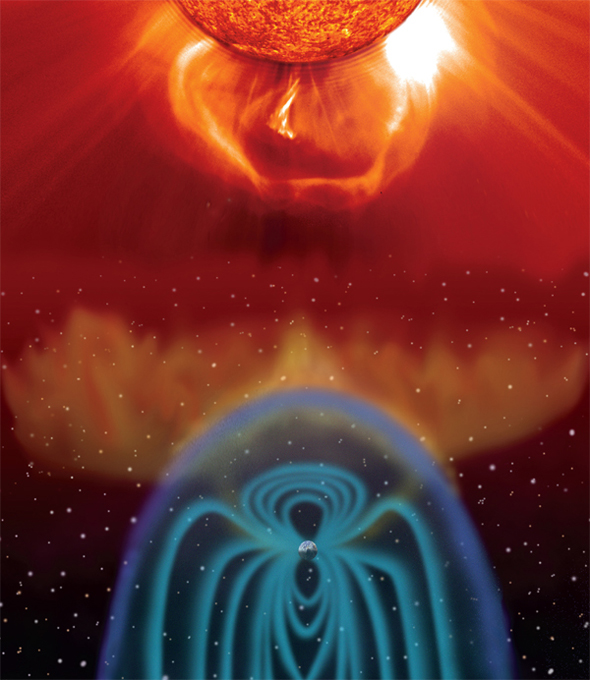
William Gilbert suggested that the Earth generated its own magnetic fields. Today, we know that a magnetosphere, represented here as a violet bubble around the Earth, is formed when charged particles from the sun interact with and are deflected by the Earth’s magnetic field.
Hans Lippershey (1570-1619), Galileo Galilei (1564-1642)
Physicist Brian Greene writes, “The invention of the telescope and its subsequent refinement and use by Galileo marked the birth of the modern scientific method and set the stage for a dramatic reassessment of our place in the cosmos. A technological device revealed conclusively that there is so much more to the universe than is available to our unaided senses.” Computer scientist Chris Langton agrees, noting, “Nothing rivals the telescope. No other device has initiated such a thoroughgoing reconstruction of our world view. It has forced us to accept the earth (and ourselves) as merely a part of the larger cosmos.”
In 1608, the German-Dutch lensmaker Hans Lippershey may have been the first to invent the telescope, and a year later, the Italian astronomer Galileo Galilei constructed a telescope with about a three-fold magnification. He later made others with up to a 30-fold magnification. Although the early telescopes were designed to observe remote objects using visible light, modern telescopes are a range of devices capable of utilizing other regions of the electromagnetic spectrum. Refracting telescopes employ lenses to form an image, while reflecting telescopes use an arrangement of mirrors for this purpose. Catadioptric telescopes use mirrors and lenses.

One antenna in the Very Large Array (VLA) used for studying signals from radio galaxies, quasars, pulsars, and more.
Interestingly, many important astronomical discoveries with telescopes have been largely unanticipated. Astrophysicist Kenneth Lang writes in Science, “Galileo Galilei turned his newly constructed spyglass to the skies, and thus began astronomers’ use of novel telescopes to explore a universe that is invisible to the unaided eye. The search for the unseen has resulted in many important unexpected discoveries, including Jupiter’s four large moons, the planet Uranus, the first asteroid Ceres, the large recession velocities of spiral nebulae, radio emission from the Milky Way, cosmic X-ray sources, Gamma-Ray Bursts, radio pulsars, the binary pulsar with its signature of gravitational radiation, and the Cosmic Microwave Background radiation. The observable universe is a modest part of a much vaster, undiscovered one that remains to be found, often in the least expected ways.”
SEE ALSO Sun-Centered Universe (1543), Discovery of Saturn’s Rings (1610), Micrographia (1665), Stellar Parallax (1838), Hubble Telescope (1990).
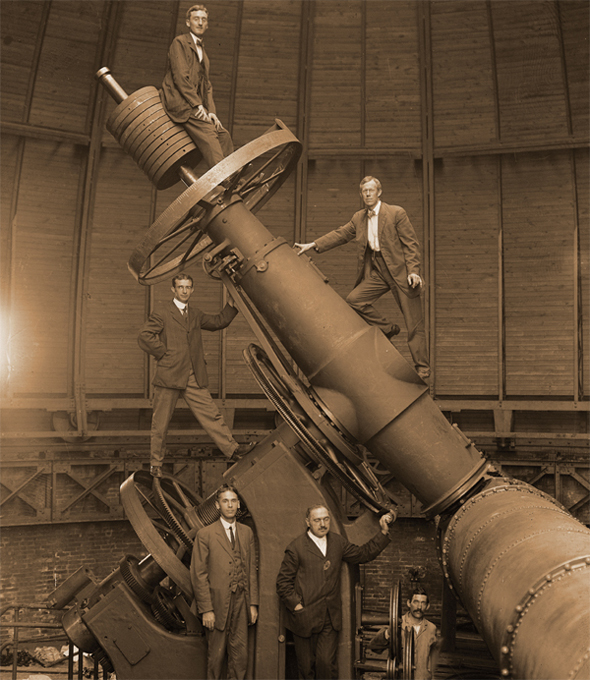
Observatory staff astride the University of Pittsburgh’s Thaw 30-inch refractor just before its completion in 1913. A man sits atop counterweights needed to keep the massive telescope in balance.
Kepler’s Laws of Planetary Motion
Johannes Kepler (1571–1630)
“Although Kepler is remembered today chiefly for his three laws of planetary motion,” writes astronomer Owen Gingerich, “these were but three elements in his much broader search for cosmic harmonies…. He left [astronomy] with a unified and physically motivated heliocentric [Sun-centered] system nearly 100 times more accurate.”
Johannes Kepler was the German astronomer and theologian-cosmologist, famous for his laws that described the elliptical orbits of the Earth and other planets around the Sun. In order for Kepler to formulate his laws, he had to first abandon the prevailing notion that circles were the “perfect” curves for describing the cosmos and its planetary orbits. When Kepler first expressed his laws, he had no theoretical justification for them. They simply provided an elegant means by which to describe orbital paths obtained from experimental data. Roughly 70 years later, Newton showed that Kepler’s Laws were a consequence of Newton’s Law of Universal Gravitation.
Kepler’s First Law (The Law of Orbits, 1609) indicated that all of the planets in our Solar System move in elliptical orbits, with the Sun at one focus. His Second Law (The Law of Equal Areas, 1618) showed that when a planet is far from the Sun, the planet moves more slowly than when it is close to the Sun. An imaginary line that connects a planet to the Sun sweeps out equal areas in equal intervals of time. Given Kepler’s first two laws, planetary orbits and positions could now be easily calculated and with an accuracy that matched observations.
Kepler’s Third Law (The Law of Periods, 1618) showed that for any planet, the square of the period of its revolution about the Sun is proportional to the cube of the semi-major axis of its elliptical orbit. Thus, planets far from the Sun have very long years. Kepler’s Laws are among the earliest scientific laws to be established by humans, and, while unifying astronomy and physics, the laws provided a stimulus to subsequent scientists who attempted to express the behavior of reality in terms of simple formulas.
SEE ALSO Sun-Centered Universe (1543), Mysterium Cosmographicum (1596), Telescope (1608), Newton’s Laws of Motion and Gravitation (1687).
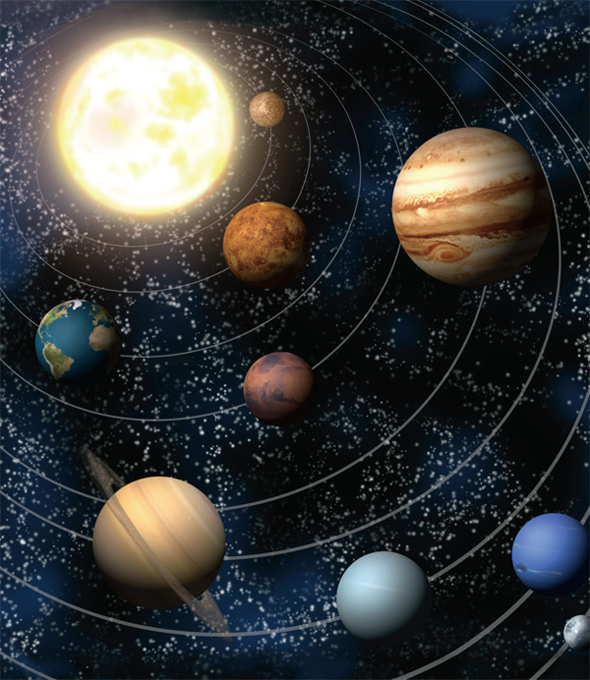
Artistic representation of the Solar System. Johannes Kepler was the German astronomer and theologian-cosmologist, famous for his laws that described the elliptical orbits of the Earth and the other planets around the sun.
Galileo Galilei (1564–1642), Giovanni Domenico Cassini (1625–1712), Christiaan Huygens (1629–1695)
“Saturn’s rings seem almost immutable,” writes science-reporter Rachel Courtland. “These planetary jewels, carved by moonlets and shaped by gravity, could well have looked much the same now as they did billions of years ago—but only from afar.” In the 1980s, a mysterious event occurred that suddenly warped the planet’s innermost rings into a ridged spiral pattern, “like the grooves on a vinyl record.” Scientists hypothesize that the spiral winding could have been caused by a very large asteroid-like object or a dramatic shift in weather.
In 1610, Galileo Galilei became the first person to observe Saturn’s rings; however, he described them as “ears.” It was not until 1655 that Christiaan Huygens was able to use his higher-quality telescope and become the first person to describe the feature as an actual ring surrounding Saturn. Finally, in 1675, Giovanni Cassini determined that Saturn’s “ring” was actually composed of subrings with gaps between them. Two such gaps have been carved out by orbiting moonlets, but other gaps remain unexplained. Orbital resonances, which result from the periodic gravitational influences of Saturn’s moons, also affect the stability of the rings. Each subring orbits at a different speed around the planet.
Today, we know that the rings consist of small particles, made almost entirely of water ice, rocks, and dust. Astronomer Carl Sagan referred to the rings being a “vast horde of tiny ice worlds, each on its separate orbit, each bound to Saturn by the giant planet’s gravity.” The particles range in size from a sand grain to the size of a house. The ring structures also have a thin atmosphere composed of oxygen gas. The rings may have been created by the debris from the breakup of some ancient moon, comet, or asteroid.
In 2009, scientists at NASA discovered a nearly invisible ring around Saturn that is so large that it would take 1 billion Earths to fill it (or about 300 Saturns lined up side to side).
SEE ALSO Telescope (1608), Measuring the Solar System (1672), Discovery of Neptune (1846).
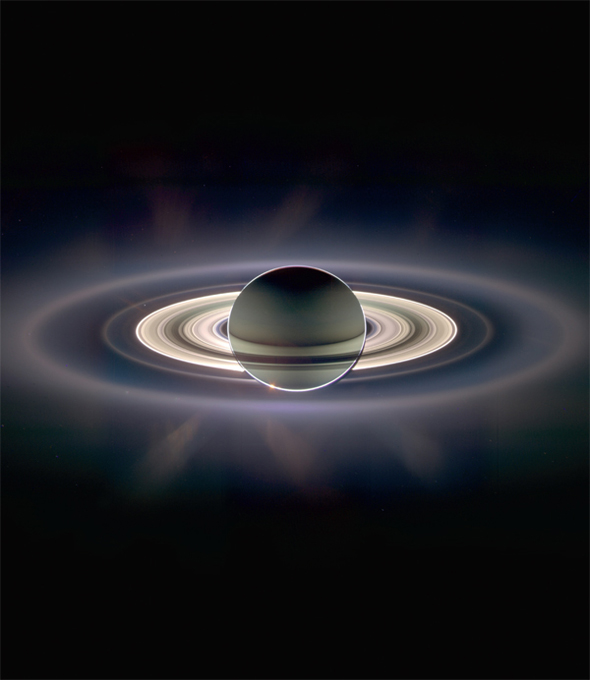
Image of Saturn and its rings made from a composite of 165 images taken by the wide-angle camera on the Cassini spacecraft. The colors in the image were created by using ultraviolet, infrared, and other photography.
Kepler’s “Six-Cornered Snowflake”
Johannes Kepler (1571-1630)
Philosopher Henry David Thoreau wrote of his awe of snowflakes, “How full of the creative genius is the air in which these are generated! I should hardly admire them more if real stars fell and lodged on my coat.” Snow crystals with hexagonal symmetry have intrigued artists and scientists throughout history. In 1611, Johannes Kepler published the monograph “On the Six-Cornered Snowflake,” which is among the earliest treatments of snowflake formations that sought a scientific understanding in contrast to a religious one. In fact, Kepler mused that it might be easier to understand the beautiful symmetry of snow crystals if they were considered as living entities with souls, each given a purpose by God. However, he considered it more likely that some kind of hexagonal packing of particles, smaller than his ability to discern, could provide an explanation of the marvelous snowflake geometries.

Rime frost on the two ends of a “capped column” snowflake.
Snowflakes (or, more rigorously, snow crystals, given that actual flakes from the sky may consist of many crystals) often begin their lives as tiny dust particles on which water molecules condense at sufficiently low temperatures. As the growing crystal falls through different atmospheric humidities and temperatures, water vapor continues to condense into solid ice, and the crystal slowly obtains its shape. The sixfold symmetry commonly seen arises from the energetically favorable hexagonal crystal structure of ordinary ice. The six arms look so similar because they all form under similar conditions. Other crystal shapes can also form, including hexagonal columns.
Physicists study snow crystals and their formation partly because crystals are important in applications ranging from electronics to the science of self-assembly, molecular dynamics, and the spontaneous formation of patterns.
Since a typical snow crystal contains about 1018 water molecules, the odds are virtually zero that two crystals of typical size are identical. At the macroscopic level, it is unlikely that any two large, complex snowflakes have ever looked completely alike—since the first snowflake fell on the Earth.
SEE ALSO Micrographia (1665), Ice Slipperiness (1850), Quasicrystals (1982).

Hexagonal dendrite snowflake, magnified by a low-temperature scanning electron microscope. The central flake has been artificially colorized for emphasis. (Agricultural Research Center)
Francis Bacon (1561–1626)
Imagine you are traveling with the ancient Native American Ute shamans in the American Midwest, hunting for quartz crystals. After collecting the crystals and placing them into ceremonial rattles made of translucent buffalo skin, you wait for the nighttime rituals to begin to summon the spirits of the dead. When it is dark, you shake the rattles and they blaze with flashes of light as the crystals collide with one another. When participating in this ceremony, you are experiencing one of the oldest known applications of triboluminescence, a physical process through which light is generated when materials are crushed, rubbed, and ripped—as electrical charges are separated and reunited. The resultant electrical discharge ionizes the nearby air, triggering flashes of light.
In 1620, the English scholar Francis Bacon published the first known documentation of the phenomena, in which he mentions that sugar will sparkle when “broken or scraped” in the dark. Today, it is easy to experiment with triboluminescence in your own home by breaking sugar crystals or Wint-O-Green Life Savers candy in a dark room. The wintergreen oil (methyl salicylate) in the candy absorbs ultraviolet light produced by the crushing of sugar and reemits it as blue light.
The spectrum of light produced by sugar triboluminescence is the same as that for lightning. In both cases, electrical energy excites nitrogen molecules in the air. Most of the light emitted by nitrogen in the air is in the ultraviolet range that our eyes cannot see, and only a small fraction is emitted in the visible range. When the sugar crystals are stressed, positive and negative charges accumulate, finally causing electrons to jump across a crystal fracture and excite electrons in the nitrogen molecules.
If you peel Scotch tape in the dark, you may also be able to see emitted light from triboluminescence. Interestingly, the process of peeling such tape in a vacuum can produce X-rays that are sufficiently strong to create an x-ray image of the finger.
SEE ALSO Stokes’ Fluorescence (1852), Piezoelectric Effect (1880), X-rays (1895), Sonoluminescence (1934).
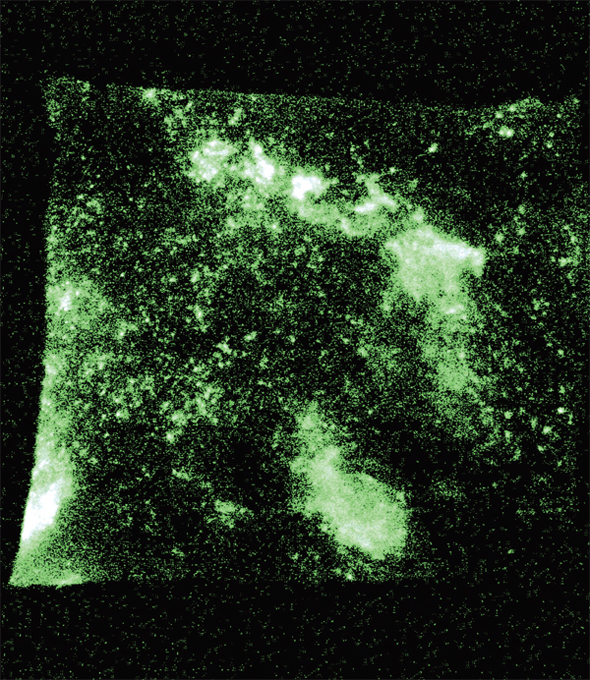
The phenomenon of triboluminescence was first discovered in 1605 by Sir Francis Bacon from scratching sugar with a knife. Shown here is a photograph of the triboluminescence of N-acetylanthranilic acid crystals crushed between two transparent windows.
Willebrord Snellius (1580-1626)
“Where art thou, beam of light?” wrote the poet James Macpherson, likely unaware of the physics of refraction. Snell’s Law concerns the bending, or refracting, of light and other waves, for example, as they travel through the air and pass into another material, such as glass. When the waves are refracted, they experience a change in the direction of propagation due to a change in their velocities. You can see Snell’s Law in action by placing a pencil into a glass of water and observing the apparent bend in the pencil. The law is expressed as n1sin(θ1) = n2sin(θ2). Here, n1 and n2 are the refractive indices of media 1 and 2. The angle between the incident light and a line perpendicular to the interface between media is called the angle of incidence (θ1). The light ray continues from medium 1 into medium 2, leaving the boundary between the media at an angle of θ2 to a line that is perpendicular to the boundary. This second angle is known as the angle of refraction.
A convex lens makes use of refraction to cause parallel light rays to converge. Without the refraction of light by the lenses in our eyes, we couldn’t see properly. Seismic waves—for example, the waves of energy caused by the sudden breaking of subterranean rock—change speed within the earth and are bent when they encounter interfaces between materials in accordance with Snell’s Law.
When a beam of light is transmitted from a material with high index of refraction to one of low index, the beam can, under some conditions, be totally reflected. This optical phenomenon is often called total internal reflection, and it occurs when light is refracted at a medium boundary to such an extent that it is reflected back. This phenomenon is observed in certain optical fibers in which the light enters at one end and remains trapped inside until it emerges from the other end. Cut diamonds often exhibit total internal reflection when the diamond sparkles and emits light in the direction of the observer’s eye.
Snell’s Law was discovered independently by various investigators over the centuries but was named after the Dutch astronomer and mathematician, Willebrord Snellius.
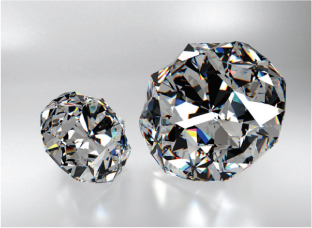
Diamonds exhibit total internal reflection.
SEE ALSO Explaining the Rainbow (1304), Newton’s Prism (1672), Brewster’s Optics (1815), Fiber Optics (1841), Green Flash (1882), Cherenkov Radiation (1934).

When an archerfish shoots streams of water at prey, the fish must compensate for light refraction when aiming. How an archerfish corrects for refraction is still not entirely explained. (Photo courtesy of Shelby Temple.)
Pierre Gassendi (1592–1655), Alfred Angot (1848–1924), Olof Petrus Hiorter (1696–1750), Anders Celsius (1701–1744)
“The aurora borealis had become a source of terror,” writes meteorologist Alfred Ango of people’s reactions in the 1500s to the appearance of luminous curtains in the sky. “Bloody lances, heads separated from the trunk, armies in conflict, were clearly distinguished. At the sight of them people fainted… others went mad.” Author George Bryson writes, “Ancient Scandinavians saw the northern lights as the recently departed souls of strong, beautiful women hovering in the air…. Electric green pierced by neon blue, shocking pink spinning into deep red, shimmering violet fading….”
Energetic charged particles streaming from the solar wind of the Sun enter the Earth’s atmosphere and are channeled toward the north and south magnetic poles of the Earth. As the particles spiral around the magnetic field lines, they collide with atmospheric oxygen and nitrogen atoms, forcing the atoms into excited states. When the electrons of the atoms return to their lower-energy ground states, they emit a light—for example, red and green for oxygen atoms—that is seen in amazing light displays near the Earth’s polar regions and that take place in the ionosphere (the uppermost part of the atmosphere, charged by solar radiation). Nitrogen may contribute a blue tinge when a nitrogen atom regains an electron after it has been ionized. When near the North Pole, the light display is called the aurora borealis. The southern counterpart is the aurora australis.
Although Cro-Magnon cave paintings exist (c. 30,000 B.C.) that appear to depict ancient auroras, it wasn’t until 1621 that the term aurora borealis was coined by Pierre Gassendi—French philosopher, priest, astronomer, and mathematician—after Aurora (the Roman goddess of dawn) and Boreas (the Greek name for “north wind”).
In 1741, Swedish astronomers Olof Petrus Hiorter and Anders Celsius suggested that auroras were controlled by magnetic effects after observing fluctuations of compass needles when auroras were in the sky. Today, we know that other planets, such as Jupiter and Saturn, have magnetic fields stronger than those of the Earth; they also have auroras.
SEE ALSO St. Elmo’s Fire (78), Rayleigh Scattering (1871), Plasma (1879), Green Flash (1882), HAARP (2007).

The Aurora Borealis, or Northern Lights, glows above Bear Lake, Eielson Air Force Base, Alaska.
Acceleration of Falling Objects
Galileo Galilei (1564–1642)
“To appreciate the full nature of Galileo’s discoveries,” writes I. Bernard Cohen, “we must understand the importance of abstract thinking, of its use by Galileo as a tool that in its ultimate polish was a much more revolutionary instrument for science than even the telescope.” According to legend, Galileo dropped two balls of different weights from the Leaning Tower of Pisa to demonstrate that they would both hit the ground at the same time. Although this precise experiment probably did not take place, Galileo certainly performed experiments that had a profound effect on contemporary understanding of the laws of motions. Aristotle had taught that heavy objects fall faster than light ones. Galileo showed that this was only an artifact of differing air resistances of the objects, and he supported his claims by performing numerous experiments with balls rolling down inclined planes. Extrapolating from these experiments, he demonstrated that if objects could fall without air resistance, all objects accelerate at the same rate. More precisely, he showed that the distance traveled by a constantly accelerating body starting at zero velocity is proportional to the square of the time falling.
Galileo also proposed the principle of inertia, in which an object’s motion continues at the same speed and direction unless acted upon by another force. Aristotle had erroneously believed that a body could be kept in motion only by applying a force. Newton later incorporated Galileo’s principle into his Laws of Motion. If it is not apparent to you that a moving object does not “naturally” stop moving without an applied force, you can imagine an experiment in which the face of a penny is sliding along an infinite smooth horizontal table that is so well oiled that there is no friction. Here, the penny would continue sliding along such an imaginary surface forever.
SEE ALSO Conservation of Momentum (1644), Tautochrone Ramp (1673), Newton’s Laws of Motion and Gravitation (1687), Clothoid Loop (1901), Terminal Velocity (1960).

Imagine spheres, or any objects, of different masses released at the same height at the same time. Galileo showed that they must all fall together at the same speed, if we neglect any differences in air resistance.
Evangelista Torricelli (1608–1647), Blaise Pascal (1623–1662)
Although the barometer is extremely simple, its implications are profound, going far beyond its usefulness for predicting the weather. The device has helped scientists understand the nature of the atmosphere and to discover that the atmosphere is finite and does not reach to the stars.
Barometers are devices used to measure atmospheric pressure and are embodied in two main forms: mercury and aneroid. In the mercury barometer, a glass tube contains mercury and is sealed at the top, while the bottom of the tube opens into a mercury-filled reservoir. The level of mercury in the tube is controlled by the atmosphere that presses down on the mercury in the reservoir. For example, under conditions of high atmospheric pressure, the mercury rises higher in the tube than when atmospheric pressure is low. In the tube, the mercury adjusts until the weight of the mercury in the column balances the atmospheric force.
Italian physicist Evangelista Torricelli is generally credited with inventing the barometer in 1643, and he observed that the height of the mercury in a barometer changed slightly each day as a result of atmospheric pressure changes. He wrote, “We live submerged at the bottom of an ocean of elementary air, which is known by incontestable experiments to have weight.” In 1648, Blaise Pascal used a barometer to show that there is less air pushing down at the top of a mountain then there is at the bottom; thus, the atmosphere did not extend forever.
In aneroid barometers, there is no moving liquid. Instead, a small flexible evacuated metal capsule is used. Inside the capsule is a spring. Small changes in atmospheric pressure cause the capsule to expand or contract. Lever mechanisms within the barometer amplify these small movements, allowing users to read pressure values.
If the atmospheric pressure is falling, this change often indicates that stormy weather is likely. Rising air pressure suggests that fair weather with no precipitation is likely.
SEE ALSO Siphon (250 B.C.), Buys-Ballot’s Weather Law (1857), Fastest Tornado Speed (1999).

A barometer, indicating atmospheric pressure in units of millimeters of mercury and in hPa (hectopascals). A pressure of one atmosphere is exactly equal to 1013.25 hPa.
René Descartes (1596-1650)
Since the time of the ancient Greek philosophers, humans have wondered about the first great question of physics: “How do things move?” The conservation of momentum, one of the great laws of physics, was discussed in an early form by philosopher and scientist René Descartes in his Principia Philosophiae (Principles of Philosophy), published in 1644.
In classical mechanics, linear momentum P is defined as the product of the mass m and velocity v of an object, P = mv, where P and v are vector quantities having a magnitude and direction. For a “closed” (i.e. isolated) system of interacting bodies, the total momentum PT is conserved. In other words, PT is constant even though the motion of the individual bodies may be changing.
For example, consider a motionless ice skater with a mass of 45 kilograms. A ball of mass 5 kilograms is tossed at her at 5 meters/second by a machine directly in front of her and a short distance away so that we can assume the ball’s flight is nearly horizontal. She catches the ball, and the impact slides her backwards at 0.5 meter/second. Here, the momentum for the moving ball and motionless skater before collision is 5 kg × 5 m/s (ball) + 0 (skater), and the momentum after collision for the skater holding the ball is (45 + 5 kg) × 0.5 m/s, thus conserving momentum.
Angular momentum is a related concept that concerns rotating objects. Consider a point mass (e.g. roughly, a ball on a string) rotating with a momentum P along a circle of radius r. The angular momentum is essentially the product of P and r—and the greater the mass, velocity, or radius, the greater the angular momentum. Angular momentum of an isolated system is also conserved. For example, when a spinning ice skater pulls in her arms, r decreases, which then causes her to spin faster. Helicopters use two rotors (propellers) for stabilization because a single horizontal rotor would cause the helicopter’s body to rotate in the opposite direction to conserve angular momentum.
SEE ALSO Acceleration of Falling Objects (1638), Newton’s Laws of Motion and Gravitation (1687), and Newton’s Cradle (1967).
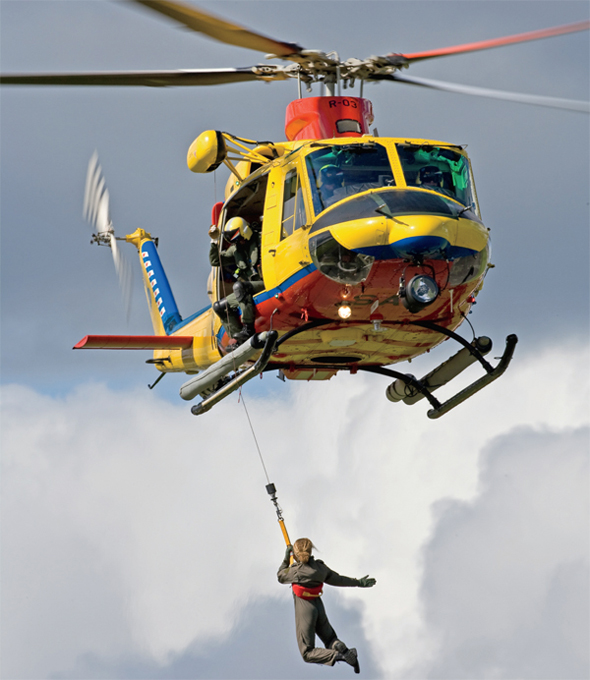
Person being winched to an air-sea rescue helicopter. Without the tail rotor for stabilization, this helicopter’s body would rotate in a direction opposite to the top rotor’s direction of spin to conserve angular momentum.
Robert Hooke (1635-1703), Augustin-Louis Cauchy (1789-1857)
I fell in love with Hooke’s Law while playing with the Slinky toy consisting of a helical spring. In 1660, the English physicist Robert Hooke discovered what we now call Hooke’s Law of Elasticity, which states that if an object, such as a metal rod or spring, is elongated by some distance, x, the restoring force F exerted by the object is proportional to x. This relationship is represented by the equation F = −kx. Here, k is a constant of proportionality that is often referred to as the spring constant when Hooke’s Law is applied to springs. Hooke’s Law is an approximation that applies for certain materials, like steel, which are called “Hookean” materials because they obey Hooke’s Law under a significant range of conditions.
Students most often encounter Hooke’s Law in their study of springs, where the law relates the force F, exerted by the spring, to the distance x that the spring is stretched. The spring constant k is measured in force per length. The negative sign in F = −kx indicates that the force exerted by the spring opposes the direction of displacement. For example, if we were to pull the end of a spring to the right, the spring exerts a “restoring” force to the left. The displacement of the spring refers to its displacement from equilibrium position at x = 0.
We have been discussing movements and forces in one direction. French mathematician Augustin-Louis Cauchy generalized Hooke’s Law to three-dimensional (3D) forces and elastic bodies, and this more complicated formulation relies on six components of stress and six components of strain. The stress-strain relationship forms a 36-component stress-strain tensor when written in matrix form.
If a metal is lightly stressed, a temporary deformation may be achieved by an elastic displacement of the atoms in the 3D lattice. Removal of the stress results in a return of the metal to its original shape and dimensions.
Many of Hooke’s inventions have been kept in obscurity, partly due to Isaac Newton’s dislike for him. In fact, Newton had Hooke’s portrait removed from the Royal Society and attempted to have Hooke’s Royal Society papers burned.
SEE ALSO Truss (2500 B.C.), Micrographia (1665), Super Ball (1965).

Chromed motorcycle suspension springs. Hooke’s Law of Elasticity helps describe how springs and other elastic objects behave as their lengths change.
Von Guericke’s Electrostatic Generator
Otto von Guericke (1602–1686), Robert Jemison Van de Graaff (1901–1967)
Neurophysiologist Arnold Trehub writes, “The most important invention in the past two thousand years must be a seminal invention with the broadest and most significant consequences. In my opinion, it is the invention by Otto von Guericke of a machine that produced static electricity.” Although electrical phenomena were known by 1660, von Guericke appears to have produced the forerunner of the first machine for generating electricity. His electrostatic generator employed a globe made of sulfur that could be rotated and rubbed by hand. (Historians are not clear if his device was continuously rotated, a feature that would make it more easy to label his generator a machine.)
More generally, an electrostatic generator produces static electricity by transforming mechanical work into electric energy. Toward the end of the 1800s, electrostatic generators played a key role in research into the structure of matter. In 1929, an electrostatic generator known as the Van de Graaff generator (VG) was designed and built by American physicist Robert Van de Graaff, and it has been used extensively in nuclear physics research. Author William Gurstelle writes, “The biggest, brightest, angriest, and most fulgent electrical discharges don’t come from Wimshurst-style electrostatic machines [see Leyden Jar] … or Tesla coils either. They come from an auditorium-sized pair of tall cylindrical machines … called Van De Graaff generators, [which] produce cascades of sparks, electrical effluvia, and strong electric fields….”
VGs employ an electronic power supply to charge a moving belt in order to accumulate high voltages, usually on a hollow metal sphere. To use VGs in a particle accelerator, a source of ions (charged particles) is accelerated by the voltage difference. The fact that the VG produces precisely controllable voltages allowed VGs to be used in studies of nuclear reactions during the designing of the atomic bomb.
Over the years, electrostatic accelerators have been used for cancer therapies, for semiconductor production (via ion implantation), for electron-microscope beams, for sterilizing food, and for accelerating protons in nuclear physics experiments.
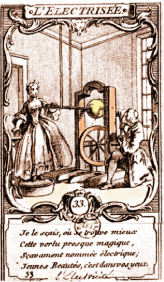
Von Guericke invented perhaps the first electrostatic generator, a version of which is illustrated in Hubert-François Gravelot’s engraving (c. 1750).
SEE ALSO Baghdad Battery (250 B.C.), De Magnete (1600), Leyden Jar (1744), Ben Franklin’s Kite (1752), Lichtenberg Figures (1777), Coulomb’s Law of Electrostatics (1785), Battery (1800), Tesla Coil (1891), Electron (1897), Jacob’s Ladder (1931), Little Boy Atomic Bomb (1945), Seeing the Single Atom (1955).
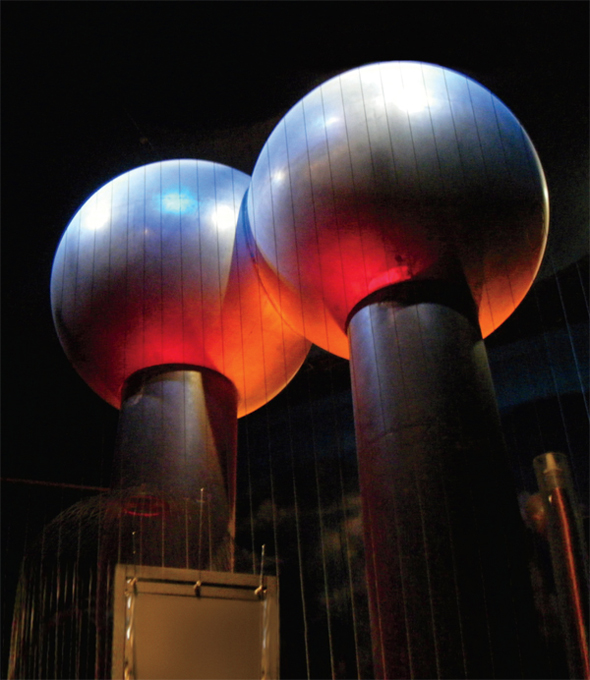
World’s largest air-insulated Van de Graaff generator, originally designed by Van de Graaff for early atomic energy experiments and currently operating in the Boston Museum of Science.
Robert Boyle (1627-1691)
“Marge, what’s wrong?” asked Homer Simpson when noticing his wife’s panic in an airplane. “Are you hungry? Gassy? Is it gas? It’s gas, isn’t it?” Perhaps Boyle’s Law would have made Homer feel a bit more knowledgeable. In 1662, Irish chemist and physicist Robert Boyle studied the relationship between the pressure P and the volume V of a gas in a container held at a constant temperature. Boyle observed that the product of the pressure and volume are nearly constant: P × V= C.
A hand-pumped bicycle pump provides a rough example of Boyle’s Law. When you push down on the piston, you decrease the volume inside the pump, increasing the pressure and causing the air to be forced into the tire. A balloon inflated at sea level will expand as it rises in the atmosphere and is subject to decreased pressure. Similarly, when we inhale, the ribs are lifted and the diaphragm contracts, increasing the lung volume and reducing the pressure so that air flows into the lungs. In a sense, Boyle’s Law keeps us alive with each breath we take.
Boyle’s Law is most accurate for an ideal gas, which consists of identical particles of negligible volume, with no intermolecular forces and with atoms or molecules that collide elastically with the walls of the container. Real gases obey Boyle’s Law at sufficiently low pressures, and the approximation is often accurate for practical purposes.
Scuba divers learn about Boyle’s Law because it helps to explain what happens during ascent and descent with respect to the lungs, mask, and buoyancy control device (BCD). For example, as a person descends, pressure increases, causing any air volume to decrease. Divers notice that their BCDs appear to deflate, and the airspace behind the ears becomes decompressed. To equalize the ear space, air must flow through the diver’s Eustachian tubes to compensate for the reduction in air volume.
Realizing that his results could be explained if all gases were made of tiny particles, Boyle attempted to formulate a universal corpuscular theory of chemistry. In his 1661 The Sceptical Chymist, Boyle denounced the Aristotelian theory of the four elements (earth, air, fire, and water) and developed the concept of primary particles that came together to produce corpuscles.
SEE ALSO Charles’ Gas Law (1787), Henry’s Gas Law (1803), Avogadro’s Gas Law (1811), Kinetic Theory (1859).

Scuba divers should know about Boyle’s Law. If divers hold their breaths during an ascent after breathing compressed air, the air in their lungs will expand as the ambient water pressure decreases, potentially causing lung damage.